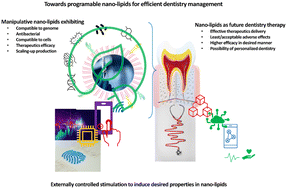Lipid nanoparticle-based formulations for high-performance dentistry applications
Abstract
In the growing field of dentistry research, there is significant scope for investigating novel and high-performance functional biomaterials for dental care, mainly to combat oral health diseases. Considering the growing economic burden on dental care, there is an urgent need to investigate affordable and biologically acceptable functional antibacterial nanostructures capable of exhibiting desired pharmacological properties. Although a wide range of materials has been investigated for dentistry applications, their acceptability and scaling-up clinical acceptance remain a challenge to cytotoxicity and alterations in cellular function. To address these challenges, nanolipids are emerging as potential materials to develop the next generation of treatment modalities for dental care and oral diseases. However, there is a need to cover the knowledge gap between developing good quality nanolipid formulations, their introduction in dental research, establishing a track from laboratory to clinical application, exploring associated risks, and proposing step-by-step systematic research to obtain FDA approval for recommending nanolipids for next-generation systems for dentistry applications. This study also summarizes the outcomes of the literature carefully and critically to provide a clear view about selecting an appropriate nanolipid system to manage a targeted dental issue. These programmable nanolipids can be designed and developed using optimized chemistry and pharmacology to be used in a controlled manner by manipulating their responsiveness according to the demand of targeted disease management, i.e., a programmable system. The future of this research, keeping clinical adaptability as a focus, is also discussed in this review, along with the possible challenges and possible alternative approaches.

- This article is part of the themed collection: Journal of Materials Chemistry B Recent Review Articles


 Please wait while we load your content...
Please wait while we load your content...